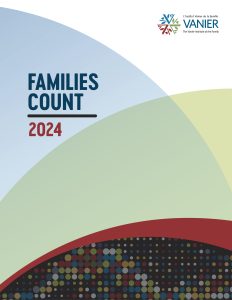Projects
Families Count 2024
Vanier Institute’s new resource explores three decades of change, continuity, and complexity among families in Canada. Released during the International Year of the Family’s 30th anniversary, Families Count 2024 provides statistical portraits of families in Canada, highlights trends over time, and offers insights on what it all means for families and family life.
Chapter 8 – Multigenerational households are one of the fastest growing household types
Multigenerational households (those housing three or more generations) have never been a dominant living arrangement in Canada. However, they have become one of the fastest growing household types in recent decades.
In 2021, there were more than 442,000 multigenerational households in Canada,1 home to 2.4 million people, or 6.4% of the total population.2 These households have grown in number by 21.2% since 2011 — much higher than the overall increase of 12.4% observed among all households.1 A growing share of children under 15 are living with grandparents, from 8.5% in 2011 to 9.1% in 2021 (93.3% of whom were living in multigenerational households).2
Data from the 2021 Census show that Indigenous and immigrant families— two fast-growing population groups— are more likely than others to live in multigenerational households. Provinces and territories with relatively higher proportions of Indigenous and/or immigrant children under 15 had the highest percentage of children who lived with grandparents. This included Nunavut (21.3%), British Columbia (13.1%), Ontario (11.8%), and the Northwest Territories (9.4%).3 Census metropolitan areasa with the highest proportion of multigenerational households were also home to some of the highest percentages of immigrants in the country, such as in Abbotsford-Mission (22%), Brampton (28%), and Markham (23%).
Among children under age five, 10.4% lived with at least one grandparent in 2021.3 This proportion was more than twice as high among First Nations (19.7%) and Inuit (24.6%) children than among non- Indigenous children (9.8%). Among the Métis children in this age group, 9.4% lived with at least one grandparent.
The higher likelihood of living in a multigenerational household also reflects the fewer options immigrant and Indigenous families may have to choose from. Most immigrant families first arrive in major urban centres, which also tend to have the highest housing prices. In 2021, multigenerational households were the most common living arrangement among First Nations people living in crowded housing (34.5%).4
Why this matters
Some families live in multigenerational households because it can help with care and caregiving between generations. Multigenerational households often include someone with an activity limitation.5 In addition, many grandparents who live with their grandchildren provide care when the parents are at work, at school, or running errands. This can help families with certain childcare costs, something with which many parents struggle.
There are many complex reasons for the increase in multigenerational households. Through income-pooling, the cost-saving advantages in these households can be important for recent immigrants and their families as they adapt to their new country and build connections. Some families may also already have a cultural preference for living with multiple generations. Families from all backgrounds may also choose to live in multigenerational households when they include new and expectant parents.
Even so, multigenerational living is not for everyone, and living with multiple generations sometimes happens out of necessity, not choice. This can result in unsuitable living arrangements, such as crowded housing, which is known to affect wellbeing.6
Source: Statistics Canada. (2022, July 13). Census family status and household living arrangements, household type of person, age group and gender: Canada, provinces and territories, census metropolitan areas and census agglomerations.2
a A census metropolitan area is a large urban centre with a population of at least 100,000 with 50% living in the core.
References
- Statistics Canada. (2022, July 13). Table 98-10-0138-01 Household type including multigenerational households and structural type of dwelling: Canada, provinces and territories, census metropolitan areas and census agglomerations. https://doi.org/10.25318/9810013801-eng ↩︎
- Statistics Canada. (2022, July 13). Table 98-10-0134-01 Census family status and household living arrangements, household type of person, age group, and gender: Canada, provinces and territories, census metropolitan areas and census agglomerations. https://doi.org/10.25318/9810013401-eng ↩︎
- Statistics Canada. (2022, September 21). Table 98-10-0278-01 Presence of grandparents in household by Indigenous identity and residence by Indigenous geography: Canada, provinces and territories. https://www150.statcan.gc.ca/t1/tbl1/en/cv.action?pid=9810027801 ↩︎
- Statistics Canada. (2022, September 21). Housing conditions among First Nations people, Métis and Inuit in Canada from the 2021 Census. Analytical products, 2021 Census. https://www12.statcan.gc.ca/census-recensement/2021/as-sa/98-200- X/2021007/98-200-X2021007-eng.cfm ↩︎
- Che-Alford, J., & Hamm, B. (1999, June 8). Under one roof: Three generations living together. Canadian Social Trends. https://www150.statcan.gc.ca/n1/pub/11-008-x/1999001/article/4575-eng.pdf ↩︎
- Waterston, S., Grueger, B., Samson, L., Canadian Paediatric Society, & Community Paediatrics Committee. (2015, October 5). Housing need in Canada: Healthy lives start at home. Paediatrics & Child Health, 20(7), 403–407. https://doi.org/10.1093/pch/20.7.403 ↩︎

Families Count 2024 is a publication of the Vanier Institute of the Family that provides accurate and timely information on families and family life in Canada. Written in plain language, it features chapters on diverse topics and trends that have shaped families in Canada. Its four sections (Family Structure, Family Work, Family Identity, and Family Wellbeing) are guided by the Family Diversities and Wellbeing Framework.
The Vanier Institute of the Family
94 Centrepointe Drive
Ottawa, Ontario K2G 6B1
[email protected]
www.vanierinstitute.ca

This work is licensed under a Creative Commons Attribution-Noncommercial 4.0 International license.
How to cite this document:
Battams, N., & Mathieu, S. (2024). Multigenerational households are one of the fastest growing household types. In Families count 2024, The Vanier Institute of the Family. https://vanierinstitute.ca/families-count-2024/multigenerational-households-are-one-of-the-fastest-growing-household-types
